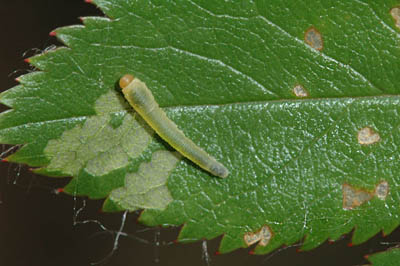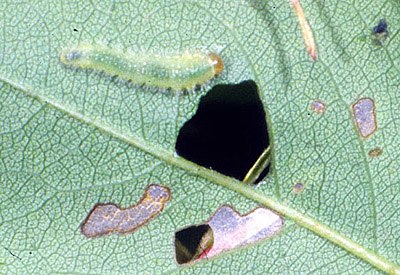A Rose Slug by Any Other Name
By Gil Medeiros, Fairfax Master Gardener
“A rose is a rose is a rose,” wrote the poet Gertrude Stein 113 years ago. However, a rose slug is NOT a slug, and it is not even a caterpillar. It is technically a wasp. Confused yet? I will try to explain.

Rose slug
If you grow roses in Fairfax, you either have rose slugs or you soon will. And those “problem-free” Knock Out roses are just as susceptible to rose slugs as any other rose.
May is the month when Rose slugs first appear.
The damage appears as irregular translucent or tan spots on the leaves. This is because the young, 1/2 inch-long larvae eat only the top surface of the leaf. Their mouthparts are not large enough to chew through to the other side. Eventually the damaged areas die, and the spots becomes holes. Enough holes and spots produce a very tattered rosebush.
Fortunately for us, there is only one generation of the European Sawfly every year. But the news is not all good on this front because there is a second type of rose slug that shows up a little later in the season to finish off what’s left of the rose foliage. It is called the Bristly Rose Slug (Cladius difformis),the larvae of a different sawfly. Typically, it shows up for dinner in late May and June. It is about 5/8 inch long and has hair-like bristles on the side of its body (you will need magnification to see these). This one chews the undersides of leaves and produces large holes until it consumes all but the biggest veins of the leaves. It can produce more than one generation in a season.
Rose slug infestations generally do not threaten the health of the plant. However, if you are fastidious about the appearance of your roses, you probably want to control the rose slugs. Some of the literature advises that you find the culprits and handpick them from the plants. Considering the extent of the havoc they wreak, rose slugs are not easy to find. I have spent hours scouting my roses only to find about ten of them on nine plants. I could have sworn there was a least a battalion at work judging from the damage they caused. Some experts advise washing the top and undersides of the leaves with a strong spray of water. I have tried that, too, with no noticeable effect.

Bristly rose slug
The Pest Management Guide also advises the use of carbaryl (active ingredient in Sevin) and deltamethrin. Be careful with these. They work as both contact insecticides and stomach poisons for insects. They will harm beneficial insects if not applied properly. Follow the label directions for best results.
Some of you with experience controlling cabbage worms on broccoli, cabbage, and kale may be wondering whether the botanical insecticide Bacillus thuringiensis kurstaki works on rose slugs. The answer is no. Cabbage worms are caterpillars; rose slugs are not. Bt kurstaki only works on caterpillars.
So, while a rose is a rose, a rose slug is a nuisance.
References
A rose is a rose is a rose, The Phrase Finder
European Rose Slug, Virginia Cooperative Extension
Rose Insects and Related Pests, Clemson Cooperative Extension, HGIC 2107
Pest Management Guide: Home Grounds and Animals, 2016, Virginia Cooperative Extension, Section 4, Home Ornamentals